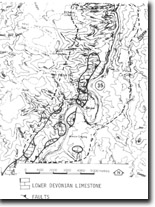8523-35 Jacksons Crossing/New Guinea Area - Snowy River Gorge
8523 - 33 to 37 - Snowy River Gorge.
This information has been developed from the publications:
|
Location: | 213670 to 160560. 12 kilometres east of Murrindal. | 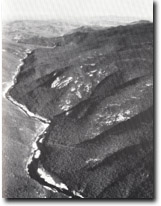 Snowy River Gorge. New Guinea (foreground), to Bengal Jungle. |
Abstract: | River gorge cut in limestone and Snowy River Volcanics, surface karst features and caves. | |
Access: | Betts Creek Track, New Guinea track and the northern extension of Basin Road. | |
Ownership: | Predominantly Crown Land (including part of Snowy River National Park) with small enclaves of private land around Jacksons Crossing. | |
Geology: | Devonian volcanics and limestone are well exposed in the cliffs of the New Guinea/Jacksons Crossing section of the Snowy River Gorge. The volcanics consist predominantly of rhyodacites with minor intercalations of rhyolites, tuffs and sediments (Fairy Member) and represent the upper part of the Snowy River Volcanics. The rhyodacties and rhyolites are highly fractured and in several localities these fractures have been filled with common opal. Neat Betts Creek, “thunder edges” have been weathered out of such a deposit. Columnar jointing in rhyodacite is well displayed in the cliffs in the Snowy River on the northern side of the New Guinea ridge and in this area differential weathering and river erosion along flow boundaries and joints has produced unusual cliff forms. Limited manganese mineralization is associated with occurrences of the Fairy Member sediments. These occur on the west side of the Snowy River at Jacksons Crossing and in Running Creek. The former is the largest deposit. It occurs in small veins and a massive lens and consists of psilomelane and pyrolusite with minor accounts of hematite. Some hand specimens show clear evidence of colloidal deposition. The contact of the Snowy River Volcanics with the Buchan Caves Limestone is poorly exposed over much of the area and consequently the nature of the contact is somewhat obscure. However, a faulted contact has been identified on the eastern side of the limestone. This fault area is exposed in a cliff to the north of the New Guinea ridge where limestone with thinly interbedded mudstone has been contorted into a large drag fold. Additionally, boulders of breccia, probably relating to the faulting, occur in the Snowy River nearby. Only the basal section of the Buchan Caves Limestone occurs in the New Guinea area. The fauna occurring in the limestone is generally richer than that of similar deposits elsewhere and includes brachiopods, e.g Chonetes, and the nautili Dectinoceras. At the base of the limestone sequence dark grey poorly fossiliferous dolomite and dolomitic limestone is predominant. This is overlain by fossiliferous calcirudite, fine to medium grained calcarenite and mudstones. Of additional interest is the colouring and banding of limestones in this area. Extremely fine grained dolomites are occasionally coloured by green or pinkish tints while pronounced colour banding (dark grey with yellow laminae) of limestone occurs. The dark grey bands contain abundant small pisolitys while the yellow bands consist of much finer flocculent laminae. | |
Geomorphology: | High river cliffs are cut in Snowy River Volcanics to the north of the New Guinea ridge. At New Guinea the Snowy River forms a large entrenched member. This feature is of interest as the river has diverted through rhyodacites rather than, as might have been expected, continued in a direct course through the less resistant limestones. Karst landforms, especially caves, are of geomorphological significance in this area. Three major cave systems have so far been investigated. These are New Guinea Cave (NG-1), Nuigini Namba Fav Cave (NG-5, NG-6) and an unnamed cave (NG-2). New Guinea Cave begins in a large spur-top doline. This system is fed by an intermittent stream and consists of passages which are essentially joint controlled and which extend for a surveyed distance of 400 m. The cave has developed on several levels, with small chambers connected by narrow and generally high stream passage (vadose canyon). The upper level passages are frequently modified by rock fall and partially infilled with clayey gravels, mud and bat guano. The cave is an important sheltering for Minopterus Schreiberii (Little Bent Wing Bat) and is regarded as one of the few caves in the area used by pregnant females for acclimatisation prior to the birth season. Nuigini Namba Fav Cave is an extensive stream passage cave which is aligned parallel to, and a few metres below, the surface gully drainage channel. The surface stream sinks into fractured Snowy River Volcanics approximately 50 m upstream from the contact with the limestones and the surface expression of the cave system is represented by several solution dolines occurring in the surface drainage channel further downstream. The cave consists of a low, wet meandering stream passage which extends for 500 m and which opens into a large chamber at the upstream end. This chamber is well decorated and contains well preserved examples of a number of uncommon cave decorations. The cave NG-2 is the outflow of a permanent stream. The source of this stream is unknown although the substantial discharge suggests a significant contribution from outside the karst area. This cave is largely joint controlled, although a short section near the entrance has formed along bedding planes and consists of a large chamber with spacious stream passage and several entrances. It is of particular important as it contains a major archaeological site. Linear markings occur in several areas on the walls and roof and these are similar to those of Koonalda Cave on the Nullarbor; this is the first such occurrence recorded in Victoria. Additionally NG-2 cave frequently contains a large number of Bent Wing Bats. These congregate in the large chamber, well into the cave. | |
Significance: | National. The exposures of Snowy River Volcanics and Buchan Caves Limestone in the cliffs of the Snowy River Gorge together with the cave systems in the limestone and the associated cave decoration, bat habitats and archeological sites warrant the designation of this area as of National significance. | |
Management: | The scientific and scenic quality of the site is dependent upon the maintenance of the Snowy River Gorge. Land use which would detract from the maintenance of this feature, for example, the construction of reservoirs, should be prohibited. The significant geomorphological, geological, zoological, and archaeological value of the limestone area warrants a detailed management plan. As knowledge of the area is incomplete continued investigation is likely to uncover additional features of considerable interest. A detailed study of the cave systems and karst can be formulated. Nevertheless, because of the fragility of much of the area, land use which would upgrade access or which would result in land disturbance should be prohibited until such time as the effects of such actions can be reliably assessed. The general principles of Karst management outlined apply to the New Guinea area. | |
References: | Ferguson, W.H. 1899. 'Report on silver-lead deposits, Murrindal River', Monthly Prog. Rep. Geol. Surv. Vict., Nos. 4 and 5 :19-20. Talent, J.A., 1955. Ringwood, A.E. 1955. 'The geology of the Deddick-Wulgumerang area, East Gippsland', Proc. R. Soc. Vict., 67 :19-66. Bradley, K. 1969. 'Geology of the Murrindal River - Yalmy River area east of Buchan, Victoria', Proc. R. Soc. Vict., 85 :277-285. Matthews, P.G. (ed). 1968. Speleological Handbook. Victorian Speleological Association. Frank, R.K. and Davey, A.G. 1976. 'Karst at New Guinea, Snowy River, Victoria', Proc. 11th. Biennial Conference Australian Speleological Federation. Canberra, 1976 (pp.114-126). O’Shea, P.J. 1980. 'Mineral Potential of the Snowy River Volcanics and Buchan Caves Limestone', Rep. Geol. Surv. Vict., No.63. | |
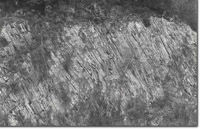 New Guinea. Columns formed by strong jointing in rhyodites of the Snowy River Volcanics. | 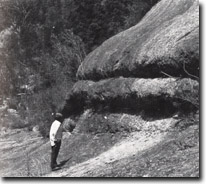 New Guinea. Weathering and erosion forms developed on rhyodacites. |
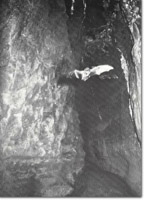 Bent-wing bats (Miniopteris shreibersii) in (NG-5). |

